8. TO TOUCH LIGHTLY IN PASSING


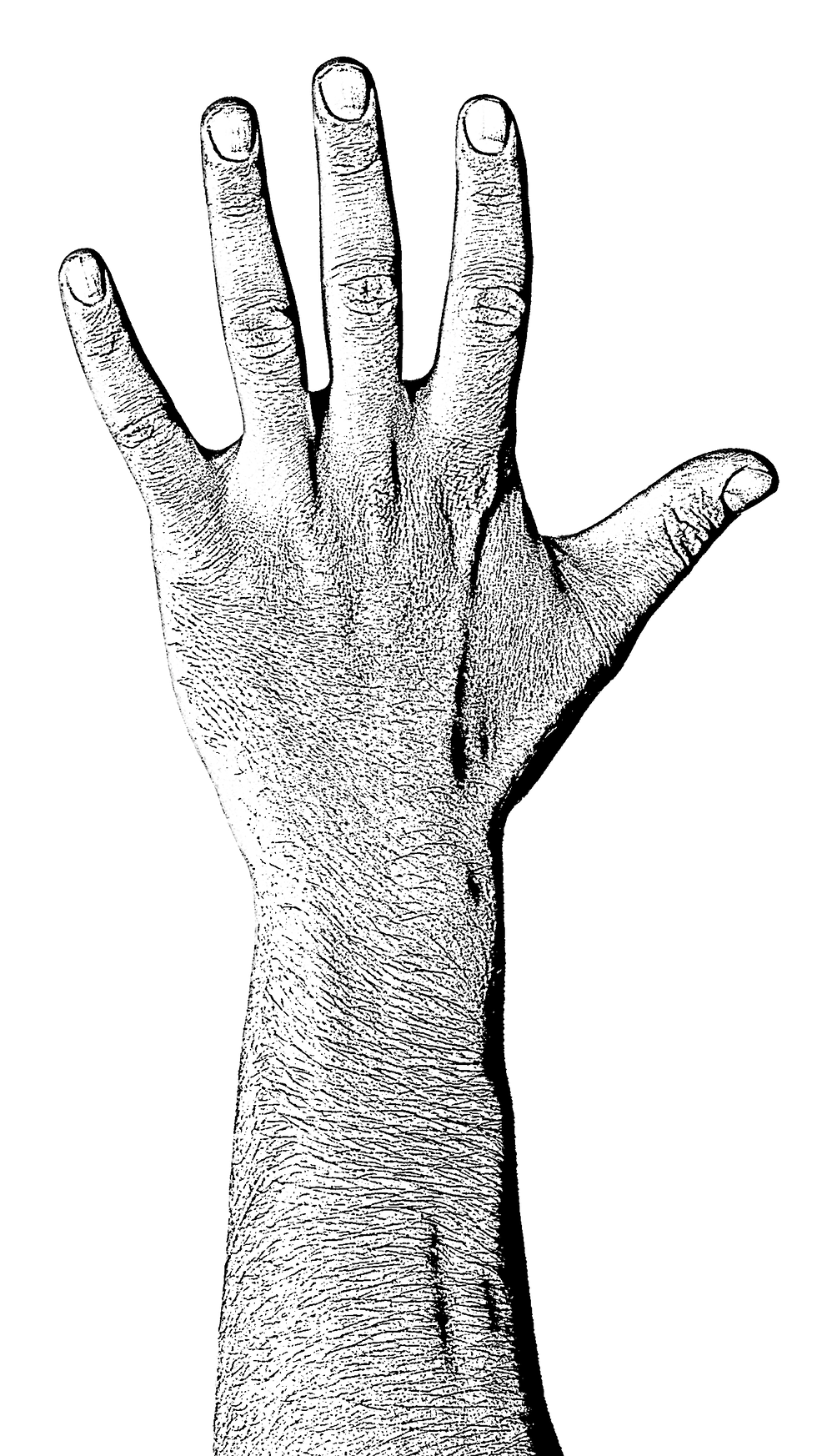




the herd
Saar and then her mother Noor,
are dusky red Lakenfelders
they show a white belted colour pattern
holding heads lower than their backs
Friendly attitude
Janneke – the leader of the herd – with her calf Sandy,
directs always her calf close nearby
Piet, definitely looking into the camera
Piet is a Fleckvieh, intersex. They has a dark brownish-reddish (brandrood) body with white socks, white tip of the tail, white face but a dark spot on their right eye, long white eye-lashes, pink nose…
holds head a bit higher than their back
ears wide
attentive attitude
and then Roos
Noor’s daughter and Saar’s older half-sister
Janneke and Cato are sisters,
Janneke, her calf Sandy and Cato are MRIJ (Meuse-Rhine-Ysel ‘Maas-Rijn-IJssel’)
Piet shows a lighter vertical stripe on his back (Aalslag)
Here is the herd
they introduce themselves by positioning in a half-circle
Surrounding
Equal distanced between the adults
Looking, watching, eye-gazing
Connecting
Relating
Earthing
Blowing time through their noses
From left to right
Cato looks at Piet.
shows a white vertical stripe on her back, a white belly and brown spots on her head, Cato is a Witrik
Cato is infertile, she adopted Piet immediately when they arrived as a small calf
(nosing, touching, licking, standing close, mooing to Piet, watching over Piet).
Family lines:
Mothers,
adoption mother,
adopted intersex,
daughters,
sisters,
half-sisters,
step siblings,
bonus calf
bonus mother
Generations Whole families Broken families

piet
The bull
– in fact the intersex cow Piet –
is sniffing, licking and sucking at my hair
just like they were a small calf in their tiny wooden box
(fieldwork 12 March 2023).
Fieldwork over the past two years taught me
how Piet wishes to take the initiative
to approach and touch me:
I have to sit down,
bow down my head,
no eye-gaze
no moving,
no reaching hands towards Piet to touch him.
Noor behind the fence is watching us.
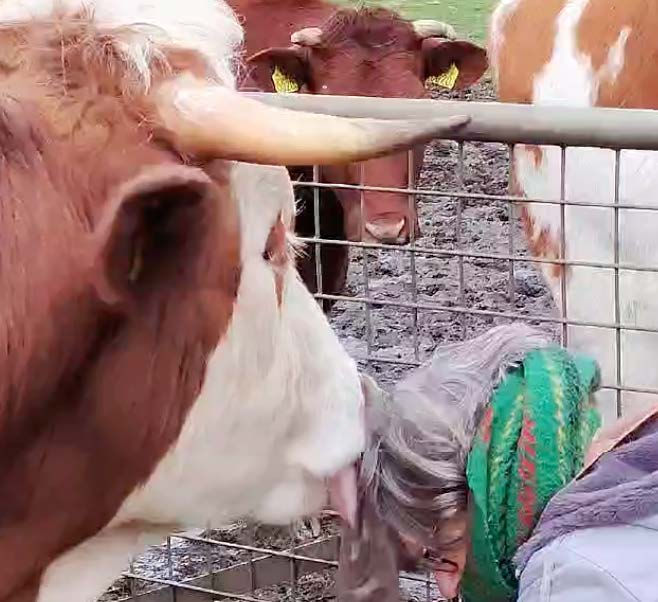
The white eye-lashes of Piet
Long eye-lashes
Big eye on the side of the head with a sight of 330 degrees
Piet’s eye still sees me when standing right next to them, both faces nosing forward
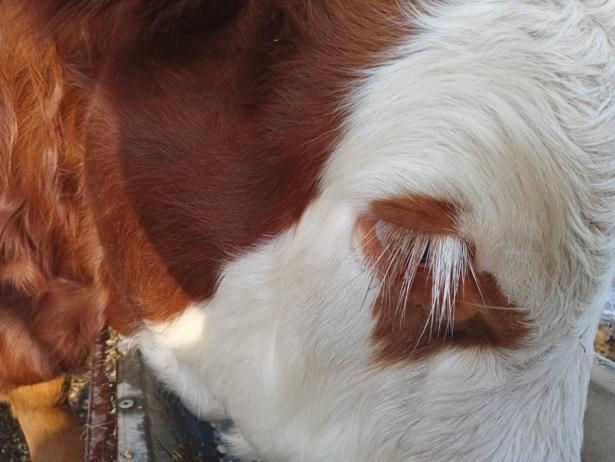

Piet does not look at the feed
where wind can slip between bodies
someone touches my hand
a small child makes a noise
the bull’s horns are warm to the touch
a bull is more body than we think
I’m right next to him
no one loses his body
and the pasture is the same body
and the pasture is a herd
and slowly we walk through the mud to the feed
I look at the ground, the feed, the bull
I am only small while the bull is big
a bull is more body than we think
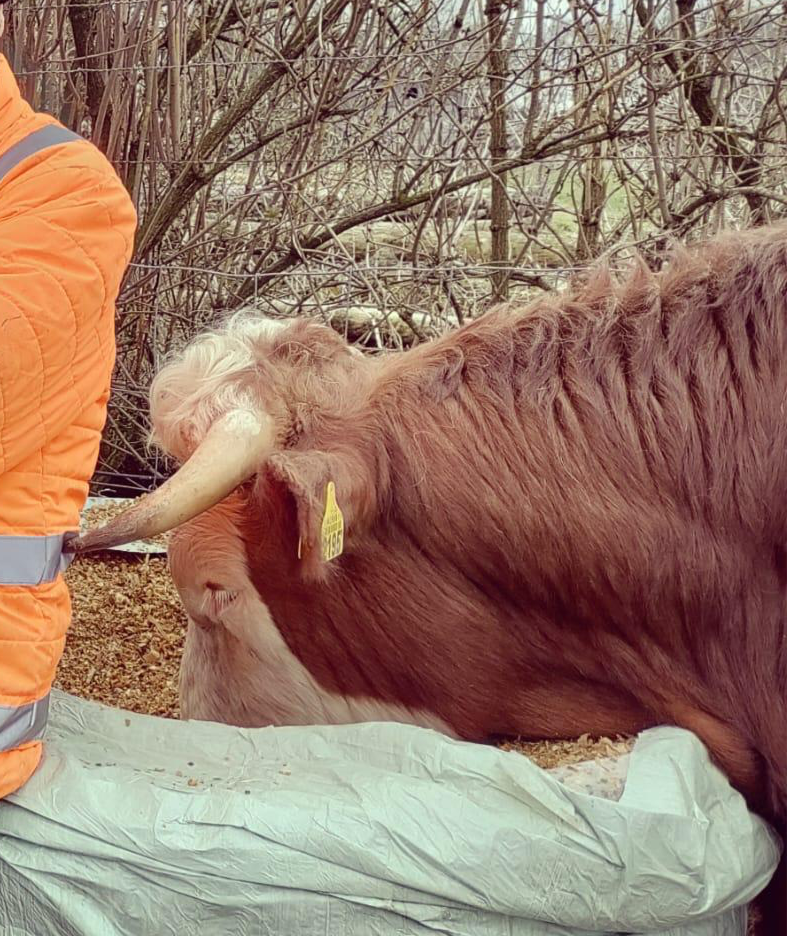

we move slowly to the next position
and stay there.
a small child makes a noise
the bull’s tongue licks a baby sock.
with baby hands the beast is touched.
it is the biggest beast that takes the lead.
piet blows out.
what do leonie and nina and merlijn grasp?
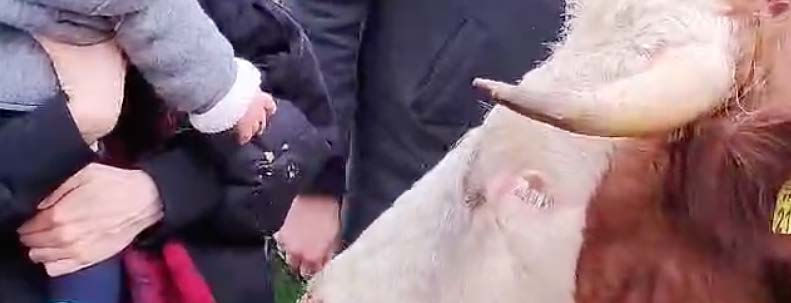
One horn and four hands, relaxed positions, mindful, holding. Four individuals reaching out to each other, interspecies-reaching-out-while-relating through smelling, sensing seeing, touching, belly-feelings.
the herd
to graze
transitive verb
(...)
1. to feed on growing herbage
2. to touch lightly in passing
Artnographic statement
In order to listen to a cow like Piet and their herd, a decentring of humans in (socio)linguistic research is needed. Such a decentring presents theoretical and methodological challenges to understandings, conceptualisations and theorising of the animal Other. The main challenge becomes that of rethinking intraspecies and interspecies interactions as embodied, multimodal and sensory phenomena whose bodily mediation draws on material objects and environments (Cornips, 2024). Instead of academic writing, poetry ideally gives the opportunity to hide and/or approach something that is unsayable or untouchable in images. For example, the tension between a bull cow and a human baby hiding in a cow lick or a baby sock, is not present in biology or related academic fields but does exist ‘in the poetry’ of or between ‘things’. That unsayable is then not necessarily in the written text but may (hopefully) subsequently arise in the minds of readers. That is another thing than capturing emotions or expressing them in academic language reserved in linguistics. Because tangible or measurable reality is bounded but our imagination is not, we need poetry to allow the world to shine through in us more completely.
Therefore, this project is a collaboration between Leonie Cornips (linguist and ethnographer), Merlijn Huntjens (poet) and Nina Willems (theatre/performance art). Nina and Merlijn have collaborated since 2015 in their art collective PANDA (see https://www.pandacollectief.nl/over-panda/). In 2024, we started developing the artistic research project called ‘KOE’ (cow), in collaboration with cow Piet and their herd, with whom Leonie has been working in the past few years. In 2023 we conducted preliminary field research with Leonie taking fieldwork photos, of which this small publication is the result.
Why did we choose to engage in this collaboration? The artistic methods, poetry in particular, allow humans to reflect and write about bodily and audible sharing activity with cows, hence synchronising together which is described by Argent (2012: 119) as part of ‘kinetic, haptic, and proxemic communication modes to create meanings’ and by de Waal (2012: 123) as ‘identification’ with the other, a process of ‘bodily mapping the self onto the other (or the other onto the self)’ which forms ‘a precondition for imitation and empathy’. By using ethnography and artistic methods the authors became increasingly sensitive to and affected by Piet’s expressive actions and movements from within our relationship through time (Servais 2018: 5) because we learned very soon to acknowledge Piet’s personhood emerging out of what we both did and do (and didn’t) in our relation (Servais, 2018: 6). Crucially, we learned almost from the beginning to consider and experience Piet not as a ‘passive object waiting to be acted upon by a desiring human subject’ (van den Hengel, 2021: 45) but that both Piet and we are ‘part of an independent web of existence where the material, social, political and spiritual dynamics of living and loving meet in co-shaping motion and being’ (Van den Hengel, 2021: 40). The strong point is that our relation is dynamic: Piet and we are being transformed by the other, articulated by what Piet makes us/our bodies do and perceive – or not – and what we make Piet/their body do and perceive – or not (Despret, 2004).
The more we collaborated the less our different roles (poet, linguist, ethnographer, performance artist, mother) became applicable; we became artistic researchers who, using all our qualities, discovered and described the world of cow Piet and their herd. Nina and Merlijn engaged in field research using Leonie’s methods, Leonie started documenting through poetry, supported by Merlijn.
Nina also took her son Olivier with her as part of the field research, as a form of ‘performance in everyday life’ (Schechner, 2006). Olivier (now fifteen months old) is fully discovering the rules of behaviour and language in the human world. What happens when we confront him with the behavioural rules and language of Piet and their herd? How does his performance affect that of Piet and the herd, and ours as human researchers? An example: in their first encounter, during the preliminary research phase, Piet bowed their head to Olivier and approached him at a slower pace than the other humans. Finally, Piet started licking Olivier’s sock. When Piet stood directly opposite Olivier, the child started to cry, and stopped when his mother placed her body between his and Piet. This affected the way Nina could perform in relation to Piet as well, because she had to turn her back to Piet, holding Olivier in her arms. Nina also noticed herself becoming very calm and slow in her movements, while she continued to try to move Olivier and Piet closer together.
The next step will be for us to design a new fieldwork method, based on our experiences so far, at the intersection of our disciplines, and to document through poetry. Poetry has our main focus for documenting, because it enables us to focus on the tactile, emotional side of communication between us and the herd we observe and interact with. We find that there are subtleties in this communication that need a different type of language from academic language. We also want to keep experimenting with hybrid presentation forms for our research.
For example, we presented a performative audio-walk as part of our project during Festival Cultura Nova 2024 in Heerlen, in collaboration with farmer Guus Huynen and the herd that lives on his farm. In the audio-walk, the audience could hear Leonie share her research, and recordings of the poetry that Nina and Merlijn created based on that research and their encounters with the cows on the farm of Guus Huynen. During the preparations, an article was published in the Dutch newspaper De Volkskrant (Embrechts, 2024) about their research. Positive reviews about the project also appeared in De Volkskrant and De Theaterkrant.

-
Argent, Gala. 2012. ‘Toward a privileging of the nonverbal: Communication, corporeal synchrony, and transcendence in humans and horses’. In Julie A. Smith and Robert W. Mitchell (eds). Experiencing Animal Minds: An Anthology of Animal-Human Encounters (pp. 111–28). New York: Columbia University Press.
-
Cornips, Leonie. 2024. ‘The semiotic repertoire of the dairy cow(s)’. Language in Society. Online first: 1–25. https://doi.org/10.1017/S0047404524000460
-
de Waal, Frans B.M. 2012. ‘A bottom-up view of empathy’. In Frans de Waal and Pier Francesco Ferrari (eds). The Primate Mind: Built to Connect with Other Minds, pp. 121–38. Cambridge/London: Harvard University Press.
-
Despret, V. 2004. ‘The body we care for: figures of anthropo-zoo-genesis’. Body and Society 10: 111–34.
-
Schechner, R. 2006. Performance Studies: An Introduction. London: Routledge.
-
Servais, V., 2018. ‘Anthropomorphism in human-animal interactions: a pragmatist view’. Frontiers in Psychology 9: 2590. https://doi.org/10.3389/fpsyg.2018.02590
-
Van den Hengel, L. 2021. ‘For love of the world: Material entanglements in ecosexual performance’. In D.C. Byrne and M. Schleicher (eds). Entanglements and Weavings: Diffractive Approaches to Gender and Love, pp. 34–53. Leiden: Brill.
-

